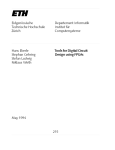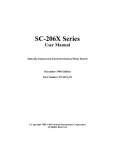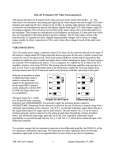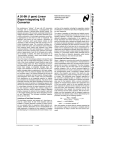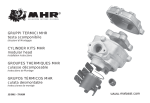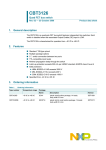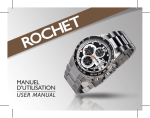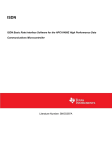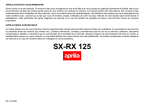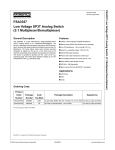Download National DS36C278 User's Manual
Transcript
DS36C278 Low Power Multipoint EIA-RS-485 Transceiver General Description Features The DS36C278 is a low power differential bus/line transceiver designed to meet the requirements of RS-485 standard for multipoint data transmission. In addition it is compatible with TIA/EIA-422-B. The CMOS design offers significant power savings over its bipolar and ALS counterparts without sacrificing ruggedness against ESD damage. The device is ideal for use in battery powered or power conscious applications. ICC is specified at 500 mA maximum. The driver and receiver outputs feature TRI-STATEÉ capability. The driver outputs operate over the entire common mode range of b7V to a 12V. Bus contention or fault situations that cause excessive power dissipation within the device are handled by a thermal shutdown circuit, which forces the driver outputs into the high impedance state. The receiver incorporates a fail safe circuit which guarantees a high output state when the inputs are left open. ² Y The DS36C278T is fully specified over the industrial temperature range (b40§ C to a 85§ C). Connection and Logic Diagram Y Y Y Y Y Y Y Y Y Y Y 100% RS-485 compliant Ð Guaranteed RS-485 device interoperation Low power CMOS design ICC 500 mA max Built-in power up/down glitch-free circuitry Ð Permits live transceiver insertion/displacement DIP and SOIC packages available b 40§ C to a 85§ C Industrial temperature range On-board thermal shutdown circuitry Ð Prevents damage to the device in the event of excessive power dissipation b 7V to a 12V Wide common mode range Receiver open input fail-safe ² t 128 nodes (/4 unit load (DS36C278) t 64 nodes (/2 unit load (DS36C278T) t 2 kV ESD (human body model) Drop in replacement for: Ð LTC485, MAX485, DS75176, DS3695 Truth Table DRIVER SECTION RE* DE DI DO/RI DO*/RI* X X X H H L H L X H L Z L H Z RECEIVER SECTION TL/F/12040 – 1 Order Number DS36C278TM, DS36C278TN, DS36C278M, DS36C278N See NS Package Number M08A or N08E RE* DE RI-RI* RO L L H L L L L L t a 0.2V H L Z H s b 0.2V X OPEN ² ² Note: Non-terminated, open input only TRI-STATEÉ is a registered trademark of National Semiconductor Corporation. C1996 National Semiconductor Corporation TL/F/12040 RRD-B30M36/Printed in U. S. A. http://www.national.com DS36C278 Low Power Multipoint EIA-RS-485 Transceiver December 1995 Absolute Maximum Ratings (Note 1) Recommended Operating Conditions If Military/Aerospace specified devices are required, please contact the National Semiconductor Sales Office/Distributors for availability and specifications. Supply Voltage (VCC) Min Typ Supply Voltage (VCC) a 4.75 a 5.0 b7 Bus Voltage Operating Free Air Temperature (Ta) b 40 DS36C278T 25 DS36C278 0 25 a 12V b 0.5V to (VCC a 0.5V) Input Voltage (DE, RE*, & DI) Common Mode (VCM) g 15V Driver Output/Receiver Input g 14V Input Voltage (DO/RI, DO*/RI*) b 0.5V to (VCC a 0.5V) Receiver Output Voltage Maximum Package Power Dissipation @ a 25§ C M Package 1190 mW, derate 9.5 mW/§ C above a 25§ C N Package 744 mW, derate 6.0 mW/§ C above a 25§ C b 65§ C to a 150§ C Storage Temperature Range a 260§ C Lead Temperature (Soldering 4 sec) a 5.25 a 12 Max Units V V a 85 a 70 §C §C Electrical Characteristics Over Supply Voltage and Operating Temperature ranges, unless otherwise specified (Notes 2 and 3) Symbol Parameter Conditions Reference Min Typ Max Units 1.5 5.0 V 0 5.0 V 0 5.0 DIFFERENTIAL DRIVER CHARACTERISTICS VOD1 Differential Output Voltage IO e 0 mA (No Load) VOD0 Output Voltage IO e 0 mA VOD0* Output Voltage (Output to GND) VOD2 Differential Output Voltage (Termination Load) RL e 50X (422) RL e 27X (485) (422) (485) DVOD2 Balance of VOD2 lVOD2 b VOD2*l RL e 27X or 50X VOD3 Differential Output Voltage (Full Load) R1 e 54X, R2 e 375X VTEST e b7V to a 12V VOC Driver Common Mode Output Voltage DVOC Balance of VOC lVOC b VOC*l IOSD Driver Output Short-Circuit Current V 2.0 2.8 1.5 2.3 5.0 V (Note 4) (422, 485) b 0.2 0.1 a 0.2 V Figure 2 1.5 2.0 5.0 V 0 3.0 V 0 3.0 V b 0.2 a 0.2 V RL e 27X (485) RL e 50X (422) Figure 1 Figure 1 V RL e 27X or RL e 50X (Note 4) (422, 485) VO e a 12V (485) Figure 4 200 a 250 mA (485) b 190 b 250 mA a 0.035 a 0.2 V VO e b7V RECEIVER CHARACTERISTICS VTH Differential Input High Threshold Voltage VO e VOH, IO e b0.4V b 7V s VCM s a 12V VTL Differential Input Low Threshold Voltage VO e VOL, IO e 0.4 mA b 7V s VCM s a 12V VHST Hysteresis VCM e 0V RIN Input Resistance b 7V s VCM s a 12V DS36C278T 24 68 kX RIN Input Resistance b 7V s VCM s a 12V DS36C278 48 68 kX http://www.national.com (Note 5) (422, 485) b 0.2 (Note 6) 2 b 0.035 V 70 mV Electrical Characteristics (Continued) Over Supply Voltage and Operating Temperature ranges, unless otherwise specified (Notes 2 and 3) Symbol IIN IING Parameter Line Input Current (Note 7) Line Input Current Glitch (Note 7) Conditions Other Input e 0V, DS36C278 DE e VIL, RE* e VIL, VCC e 4.75 to 5.25 DS36C278T or 0V Other Input e 0V, DS36C278 DE e VIL, RE* e VIL, VCC e a 3.0V or 0V, DS36C278T TA e 25§ C IB Input Balance Test RS e 500X VOH High Level Output Voltage IOH e b4 mA, VID e a 0.2V VOL Low Level Output Voltage IOL e a 4 mA, VID e b0.2V IOSR Short Circuit Current VO e GND IOZR TRI-STATE Leakage Current VO e 0.4V to 2.4V Reference Min Typ Max Units VIN e a 12V 0 0.19 0.25 mA VIN e b7V 0 b 0.1 b 0.2 mA VIN e a 12V 0 0.19 0.5 mA VIN e b7V 0 b 0.1 b 0.4 mA VIN e a 12V 0 0.19 0.25 mA VIN e b7V 0 b 0.1 b 0.2 mA VIN e a 12V 0 0.19 0.5 mA VIN e b7V 0 b 0.1 b 0.4 mA g 400 mV (422) (Note 9) 3.5 RO Figure 11 7 RO 4.6 V 0.3 0.5 V 35 85 mA g1 mA DEVICE CHARACTERISTICS VIH High Level Input Voltage 2.0 VCC V VIL Low Level Input Voltage GND 0.8 V IIH High Level Input Current VIH e VCC IIL Low Level Input Current VCC e 5V VCC e a 3.0V ICC ICCR Power Supply Current (No Load) DE, RE*, DI VIL e 0V Driver and Receiver ON 200 Driver OFF, Receiver ON ICCD Driver ON, Receiver OFF ICCZ Driver and Receiver OFF VCC 2 mA b2 mA b2 mA 500 mA 200 500 mA 200 500 mA 200 500 mA Switching Characteristics Over Supply Voltage and Operating Temperature ranges, unless otherwise specified (Notes 3 and 8) Symbol Parameter Conditions Reference Min Typ Max Units 10 39 80 ns 10 40 80 ns 0 1 10 ns ns DRIVER CHARACTERISTICS tPHLD Differential Propagation Delay High to Low tPLHD Differential Propagation Delay Low to High RL e 54X, CL e 100 pF Figures 5, 6 tSKD Differential Skew ltPHLD b tPLHDl tr Rise Time 3 25 50 tf Fall Time 3 25 50 ns tPHZ Disable Time High to Z CL e 15 pF Figures 7, 8 Ð 80 200 ns tPLZ Disable Time Low to Z RE * e L Figures 9, 10 Ð 80 200 ns tPZH Enable Time Z to High CL e 100 pF Figures 7, 8 Ð 50 200 ns tPZL Enable Time Z to Low RE * e L Figures 9, 10 Ð 65 200 ns 3 http://www.national.com Switching Characteristics (Continued) Over Supply Voltage and Operating Temperature ranges, unless otherwise specified (Notes 3 and 8) Symbol Parameter Conditions Reference Min Typ Max Units 30 210 400 ns 30 190 400 ns 0 20 50 ns Ð 50 150 ns Ð 55 150 ns Ð 40 150 ns Ð 45 150 ns RECEIVER CHARACTERISTICS tPHL Propagation Delay High to Low tPLH Propagation Delay Low to High tSK Skew, ltPHL b tPLHl tPLZ Output Disable Time CL e 15 pF Figures 12, 13 CL e 15 pF tPHZ tPZL Figures 14, 15, 16 Output Enable Time tPZH Note 1: ‘‘Absolute Maximum Ratings’’ are those values beyond which the safety of the device cannot be guaranteed. They are not meant to imply that the devices should be operated at these limits. The table of ‘‘Electrical Characteristics’’ specifies conditions of device operation. Note 2: Current into device pins is defined as positive. Current out of device pins is defined as negative. All voltages are referenced to ground except VOD1 and VOD2. Note 3: All typicals are given for: VCC e a 5.0V, TA e a 25§ C. Note 4: Delta l VOD2 l and Delta l VOC l are changes in magnitude of VOD2 and VOC, respectively, that occur when input changes state. Note 5: Threshold parameter limits specified as an algebraic value rather than by magnitude. Note 6: Hysteresis defined as VHST e VTH b VTL. Note 7: IIN includes the receiver input current and driver TRI-STATE leakage current. Note 8: CL includes probe and jig capacitance. Note 9: For complete details of test, see RS-485. Parameter Measurement Information TL/F/12040 – 18 TL/F/12040–2 FIGURE 2. Driver VOD3 FIGURE 1. Driver VOD2 and VOC TL/F/12040 – 4 TL/F/12040–3 Vtest e b7V to a 12V FIGURE 4. Driver IOSD FIGURE 3. Driver VOH and VOL TL/F/12040 – 5 FIGURE 5. Driver Differential Propagation Delay Test Circuit http://www.national.com 4 Parameter Measurement Information (Continued) TL/F/12040 – 6 FIGURE 6. Driver Differential Propagation Delays and Differential Rise and Fall Times TL/F/12040 – 8 FIGURE 8. TRI-STATE Waveforms (tPZH, tPHZ) TL/F/12040 – 7 FIGURE 7. TRI-STATE Test Circuit (tPZH , tPHZ) TL/F/12040 – 10 FIGURE 10. TRI-STATE Waveforms (tPZL, tPLZ) TL/F/12040 – 9 FIGURE 9. TRI-STATE Test Circuit (tPZL, tPLZ) TL/F/12040 – 12 FIGURE 12. Receiver Differential Propagation Delay Test Circuit TL/F/12040 – 11 FIGURE 11. Receiver VOH and VOL 5 http://www.national.com Parameter Measurement Information (Continued) TL/F/12040 – 13 FIGURE 13. Receiver Differential Propagation Delay Waveforms TL/F/12040 – 14 FIGURE 14. Receiver TRI-STATE Test Circuit TL/F/12040 – 15 FIGURE 15. Receiver Enable and Disable Waveforms (tPLZ, tPZL) TL/F/12040 – 16 FIGURE 16. Receiver Enable and Disable Waveforms (tPHZ, tPZH) http://www.national.com 6 Typical Application Information TL/F/12040 – 17 FIGURE 17. Typical RS-485 Bus Interface TABLE I. Device Pin Descriptions Pin No. Name Description 1 RO Receiver Output: When RE (Receiver Enable) is LOW, the receiver is enabled (ON), if DO/RI t DO*/RI* by 200 mV, RO will be HIGH. If DO/RI s DO*/RI* by 200 mV, RO will be LOW. Additionally RO will be HIGH for OPEN (Non-terminated) Inputs. 2 RE* Receiver Output Enable: When RE* is LOW the receiver output is enabled. When RE* is HIGH, the receiver output is in TRI-STATE (OFF). 3 DE Driver Output Enable: When DE is HIGH, the driver outputs are enabled. When DE is LOW, the driver outputs are in TRI-STATE (OFF). 4 DI Driver Input: When DE (Driver Enable) is HIGH, the driver is enabled, if DI is LOW, then DO/RI will be LOW and DO*/RI* will be HIGH. If DI is HIGH, then DO/RI is HIGH and DO*/RI* is LOW. 5 GND 6 DO/RI 7 DO*/RI* 8 VCC Ground Connection. Driver Output/Receiver Input, 485 Bus Pin. Driver Output/Receiver Input, 485 Bus Pin. Positive Power Supply Connection: Recommended operating range for VCC is a 4.75V to a 5.25V. Unit Load at a 0.25 mA for the top border and b7V at b0.2 mA for the bottom border (see Figure 18 ). A unit load for an RS-485 receiver is defined by the input current versus the input voltage curve. The gray shaded region is the defined operating range from b7V to a 12V. The top border extending from b3V at 0 mA to a 12V at a 1 mA is defined as one unit load. Likewise, the bottom border extending from a 5V at 0 mA to b7V at b0.8 mA is also defined as one unit load (see Figure 18 ). An RS-485 driver is capable of driving up to 32 unit loads. This allows up to 32 nodes on a single bus. Although sufficient for many applications, it is sometimes desirable to have even more nodes. For example, an aircraft that has 32 rows with 4 seats per row would benefit from having 128 nodes on one bus. This would allow signals to be transferred to and from each individual seat to 1 main station. Usually there is one or two less seats in the last row of the aircraft near the restrooms and food storage area. This frees the node for the main station. The DS36C278, the DS36C279, and the DS36C280 all have (/2 unit load and (/4 unit load (UL) options available. These devices will allow up to 64 nodes or 128 nodes guaranteed over temperature depending upon which option is selected. The (/2 UL option is available in industrial temperature and the (/4 UL is available in commercial temperature. First, for a (/2 UL device the top and bottom borders shown in Figure 18 are scaled. Both 0 mA reference points at a 5V and b3V stay the same. The other reference points are a 12V at a 0.5 mA for the top border and b 7V at b 0.4 mA for the bottom border (see Figure 18 ). Second, for a (/4 UL device the top and bottom borders shown in Figure 18 are scaled also. Again, both 0 mA reference points at a 5V and b 3V stay the same. The other reference points are a 12V The advantage of the (/2 UL and (/4 UL devices is the increased number of nodes on one bus. In a single master multi-slave type of application where the number of slaves exceeds 32, the DS36C278/279/280 may save in the cost of extra devices like repeaters, extra media like cable, and/or extra components like resistors. The DS36C279 and DS36C280 have an additional feature which offers more advantages. The DS36C279 has an automatic sleep mode function for power conscious applications. The DS36C280 has a slew rate control for EMI conscious applications. Refer to the sleep mode and slew rate control portion of the application information section in the corresponding datasheet for more information on these features. TL/F/12040 – 19 FIGURE 18. Input Current vs Input Voltage Operating Range 7 http://www.national.com http://www.national.com 8 Physical Dimensions inches (millimeters) 8-Lead (0.150× Wide) Molded Small Outline Package, JEDEC Order Number DS36C278TM, DS36C278M NS Package Number M08A 9 http://www.national.com DS36C278 Low Power Multipoint EIA-RS-485 Transceiver Physical Dimensions inches (millimeters) (Continued) 8-Lead (0.300× Wide) Molded Dual-In-Line Package Order Number DS36C278TN, DS36C278N NS Package Number N08E LIFE SUPPORT POLICY NATIONAL’S PRODUCTS ARE NOT AUTHORIZED FOR USE AS CRITICAL COMPONENTS IN LIFE SUPPORT DEVICES OR SYSTEMS WITHOUT THE EXPRESS WRITTEN APPROVAL OF THE PRESIDENT OF NATIONAL SEMICONDUCTOR CORPORATION. As used herein: 1. Life support devices or systems are devices or systems which, (a) are intended for surgical implant into the body, or (b) support or sustain life, and whose failure to perform, when properly used in accordance with instructions for use provided in the labeling, can be reasonably expected to result in a significant injury to the user. National Semiconductor Corporation 1111 West Bardin Road Arlington, TX 76017 Tel: 1(800) 272-9959 Fax: 1(800) 737-7018 http://www.national.com 2. A critical component is any component of a life support device or system whose failure to perform can be reasonably expected to cause the failure of the life support device or system, or to affect its safety or effectiveness. National Semiconductor Europe Fax: a49 (0) 180-530 85 86 Email: europe.support @ nsc.com Deutsch Tel: a49 (0) 180-530 85 85 English Tel: a49 (0) 180-532 78 32 Fran3ais Tel: a49 (0) 180-532 93 58 Italiano Tel: a49 (0) 180-534 16 80 National Semiconductor Hong Kong Ltd. 13th Floor, Straight Block, Ocean Centre, 5 Canton Rd. Tsimshatsui, Kowloon Hong Kong Tel: (852) 2737-1600 Fax: (852) 2736-9960 National Semiconductor Japan Ltd. Tel: 81-043-299-2308 Fax: 81-043-299-2408 National does not assume any responsibility for use of any circuitry described, no circuit patent licenses are implied and National reserves the right at any time without notice to change said circuitry and specifications.










